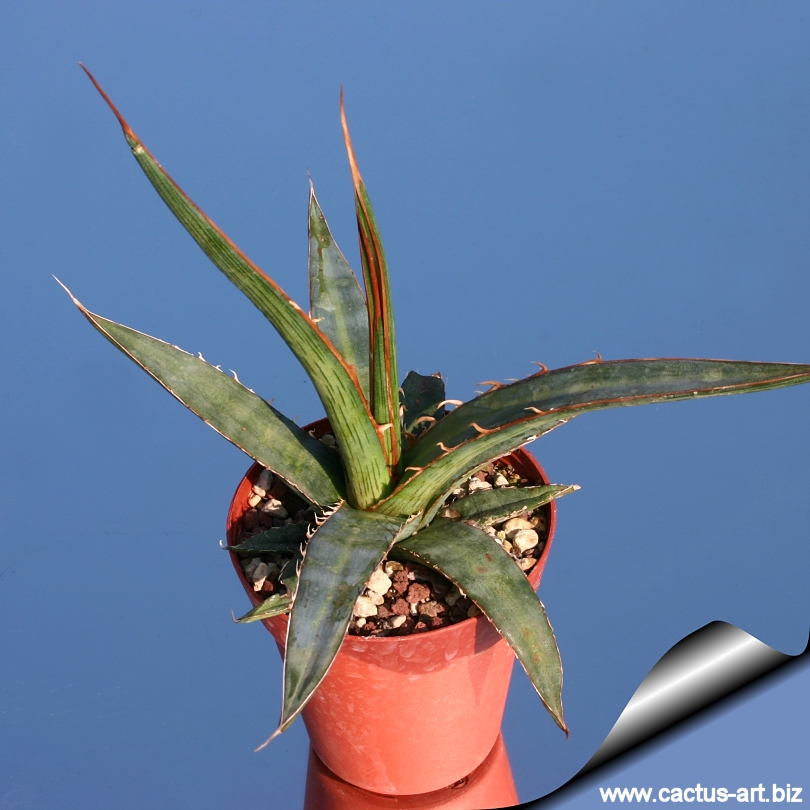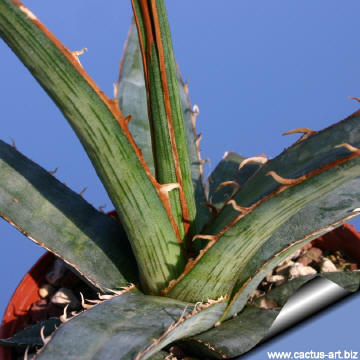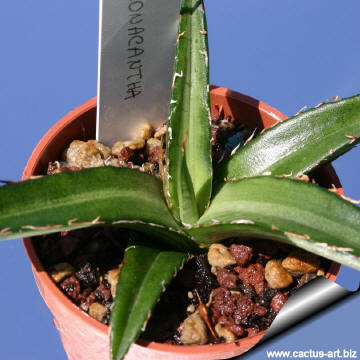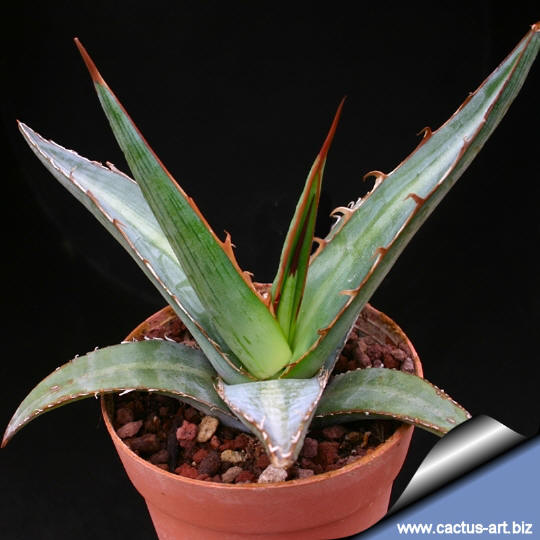|
|
|

Agave xylonacantha (A juvenile specimen)
The
saw leaf Agave is a standout.
Young plants are quite different from the adults, but are however very
lovely too.
|
|
Description:
The plant generally produces a single rosette but some plants will
produce offsets with time. Each rosette grows up to 30 cm tall and 120
cm wide and has an open, free form and produces relatively few leaves
compared to other agaves.
Stem: Short.
Leaves: Few (not more than 20 per plant) 40-90 cm long, 5-10 cm
wide. Ensiform-lanceolate, tappering from the base, rather rigid, rough,
often broadest in the middle, long-accuminated, rounded below, plane to
concave above. The margins of the leaves have broad, flat, light
coloured almost papery spines on broad teats (usually 2-5 cm apart) that
run together along the leaf margin that are arranged in an irregular
fashion, making the leaves look like old fashioned wood saw blades. Leaf
colour varies from seedling to seedling, ranging from acid-green, to
dull blue-green to olive-green to almost silver (rarely yellow green)
with a lighter centre stripe. Terminal spine, trigonus-subulate, grooved
at the base, stout, 2,5-5 cm, pale brown to light grey.
Inflorescence: Erect 3-6 m tall, sinuous, spicate and long
tappering, flowering in the upper ˝ or ⅓ part.
Flowers: 3-8 together, 40-50 mm long, ovarium fusiform, 20-35 mm
long, tepals greenish to pale yellow, tube 3-5 mm long, lobes equal
15-20 mm long.
This plant is related
to A. lophantha. The leaf margins with large flattened,
several tipped, teeth are like an exaggeration of the forms known of
A. lophantha.
|
 |
 |
|
Advertising
|
|
|
|
|
|
|
Family: Agavaceae
Scientific Name:
Agave xylonacantha
Salm-Dyck
In: Bonplandia 7:92, 1859
Origin: Mexico (Nuevo León,
Hidalgo, San Luis Potosi, Tamaulipas, Guanajuato, Queretaro)
Habitat: Mountain
dry limestone slopes and valleys on of desert side of the Sierra Madre
Orientale at elevations about 900-1000 in the Mexican States of
Tamaulipas, San Luis Potosim and Hildalgo.
Etymology: The species
name "xylonacantha" means "with woody spines"
in a fitting reference to the broad wood colored spines. One of the
previous used names of this plant, Agave carchariodonta
was in reference to the teeth (odonta) of
the Great White Shark, Carcharodon carcharias.
Synonyms:
- Agave carchariodonta
Pampanini 1907
- Agave kochii Jacobii
1866
- Agave maximilliana
Hort. Ex Besaucčle (nom. Illeg. Art. 53.1)
- Agave vittata Regel
1858
- Agave amurensis
Jacobi 1864
- Agave splendens
Jacobi 1870
- Agave perbella hort.
Ex Backer 1877
- Agave vanderdonckii
hort. Ex Baker 1877
- Agave xylacantha hort.
Ex Baker 1877
- Agave noli-tangere A.
berger 1915
|
|
|
|

Cultivation: A.
xylonacantha
is a stunning specimen
plant for containers or a well drained spot in the garden noted as rare
in cultivation. It tend to be
slow grower, but worth the effort. Grow them in porous soil with
adequate drainage. They do well in full sun or
a lightly shaded area. Water
thoroughly when soil is dry to the touch. In
winter watering this plant can be done once every 1-2 months, there is
no need to mist the leaves. It is theoretically hardy to -3° C,
particularly when dry but it is best to avoid severe
freezing temperatures. Heat Tolerance: Excellent.
Propagation:
Relatively easy to propagate by seeds or by
suckers (if available) Remove the basal suckers in spring or
summer and let the cuttings dry for a few days before inserting in
compost.. only problem is the
logistics of getting to the suckers - very sharp spines and suckers
usually right up against, or underneath the mother plant.
Use:
These striking plants are wonderful when used for accent or simply to
provide some all year round foliage colour and often used in a pot as a
patio plant, they make an eye-catching statement and along with other
evergreen plants in pots, can be moved around to change the scenery or
position to give more shelter.
|
|

 |
|